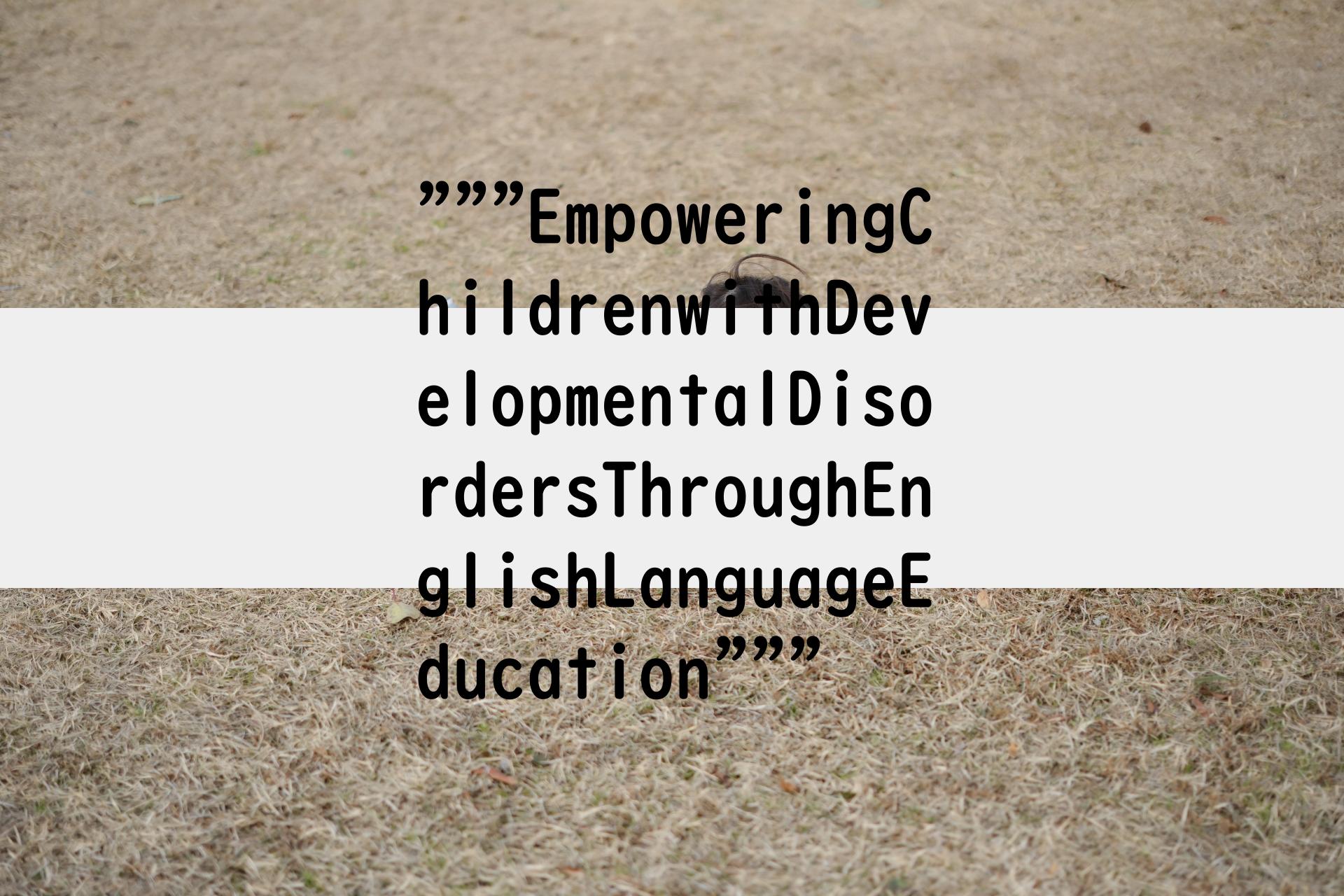- “Breaking Barriers: Teaching English to Children with Developmental Disorders”
- “Unlocking Communication: How English Language Learning Can Benefit Children with Developmental Disabilities”
- “Tips and Tricks for Teaching English to Children on the Autism Spectrum”
- “Inclusive Language Learning: Supporting Children with ADHD in English Classrooms”
- “Meeting the Unique Needs of Dyslexic Children in English Language Education”
“Breaking Barriers: Teaching English to Children with Developmental Disorders”
“BreakingBarriers:TeachingEnglishtoChildrenwithDevelopmentalDisorders”Asateacher,oneofthemostrewardingexperiencesisseeingtheprogressandgrowthofourstudents.However,whenthatstudenthasadevelopmentaldisorder,itcanbechallengingtoknowhowtoeffectivelyteachandcommunicatewiththem.ThischallengeisamplifiedwhenteachingasecondlanguagelikeEnglish.Childrenwithdevelopmentaldisorderssuchasautism,ADHD,orDownsyndrome,oftenstrugglewithlanguageacquisitionandcommunication.However,thisdoesnotmeantheycannotlearnasecondlanguage.Infact,researchhasshownthatearlyexposuretoasecondlanguagecanimprovecognitivedevelopmentandsocialcommunicationskillsinchildrenwithdevelopmentaldisorders.ToeffectivelyteachEnglishtochildrenwithdevelopmentaldisorders,itisimportanttounderstandtheirindividualneedsandlearningstyles.Somechildrenmaybenefitfromvisualaids,whileothersmayrespondbettertohands-onactivities.Itisalsoimportanttoestablisharoutineandstructureintheclassroomtoprovideasenseofstabilityandpredictabilityforthechild.Effectivecommunicationisessentialwhenworkingwithchildrenwithdevelopmentaldisorders.Teachersshouldusesimplelanguage,shortsentences,andvisualcuestoaidincomprehension.Additionally,itisimportanttoprovidepositivereinforcementandpraisewhenthechilddemonstratesprogressandmasteryoflanguageskills.IncorporatingtechnologyandmultimediaresourcescanalsobebeneficialwhenteachingEnglishtochildrenwithdevelopmentaldisorders.Interactivegamesandvideoscanmakelanguagelearningmoreengagingandenjoyableforthesestudents.Inconclusion,teachingEnglishtochildrenwithdevelopmentaldisordersrequirespatience,creativity,andawillingnesstoadapttoeachchild’sindividuallearningneeds.Withtherightstrategiesandresources,wecanbreakdownbarriersandprovidethesestudentswiththeopportunitytolearnasecondlanguageandenhancetheircognitiveandsocialdevelopment.
“Unlocking Communication: How English Language Learning Can Benefit Children with Developmental Disabilities”
近年、発達障害を抱える児童に対する英語教育の必要性が注目されています。
“UnlockingCommunication:HowEnglishLanguageLearningCanBenefitChildrenwithDevelopmentalDisabilities”というタイトルのこの記事では、この問題に焦点を当て、英語学習が発達障害を抱える児童に与える恩恵について探求します。発達障害を抱える児童は、感覚過敏やコミュニケーション能力の低下などの問題を抱えることがあります。このような問題を解決するために、英語学習は有効なツールになるかもしれません。英語学習により、児童は異なる文化や環境に触れることができ、コミュニケーションスキルを向上させることができます。また、英語学習は児童の認知能力を改善することができます。言語学習により、児童は脳の機能を発達させ、問題解決能力や創造性の向上につながります。さらに、英語学習は児童の社会的・情緒的な発達にも影響を与えます。英語ができることにより、児童は自信を持つことができ、自尊心を高めることができます。また、異なる文化や環境に触れることにより、児童は多様性に対する理解を深めることができます。英語学習が発達障害を抱える児童に与える恩恵は多岐にわたります。しかし、児童に合った英語学習の方法やプログラムを選ぶことが重要です。児童のニーズに合わせた英語教育を提供し、児童の発展をサポートすることが求められています。このように、英語学習は発達障害を抱える児童にとって有益なツールになることがわかりました。教育者や保護者は、児童の個性を尊重しながら、英語学習を通じて児童の成長を促進することが必要です。
“Tips and Tricks for Teaching English to Children on the Autism Spectrum”
TipsandTricksforTeachingEnglishtoChildrenontheAutismSpectrumTeachinganewlanguagetochildrenontheautismspectrumcanbechallenging.Butwiththerightstrategiesandapproaches,itcanbearewardingandfunexperienceforboththeteacherandthestudent.HerearesometipsandtricksforteachingEnglishtochildrenontheautismspectrum:1.Usevisualaids:Childrenontheautismspectrumtendtobevisuallearners.Usingpictures,videos,andflashcardscanhelpreinforcevocabularyandsentencestructure.2.Sticktoaroutine:Childrenwithautismthriveonstructureandroutine.Keepingaconsistentscheduleandusingthesameteachingmethodseachdaycanhelpcreateasenseofsecurityandfamiliarityforthestudent.3.Breakdownlanguageintosmallerpieces:Complexgrammarrulesandvocabularycanbeoverwhelmingforchildrenwithautism.Breakingdownlanguageintosmaller,moremanageablepiecescanhelpthestudentunderstandandretaintheinformation.4.Usehands-onactivities:Childrenwithautismoftenhavetroublewithabstractconcepts.Usinghands-onactivities,suchasgamesorpuzzles,canhelpmakelanguagelearningmoreconcreteandengaging.5.Bepatientandflexible:Childrenwithautismmayneedmoretimeandrepetitiontolearnnewlanguageskills.Beingpatientandflexiblecanhelpcreateapositivelearningenvironmentandencouragethestudenttosucceed.6.Usepositivereinforcement:Positivereinforcement,suchaspraiseorrewards,canbeapowerfulmotivatorforchildrenwithautism.Usingthesestrategiescanhelpbuildconfidenceandencouragethestudenttocontinuelearning.7.Buildontheirinterests:Childrenwithautismoftenhavestronginterestsinparticulartopics.BuildingEnglishlessonsaroundtheirinterestscanhelpcreateamoreengagingandmeaningfullearningexperienceforthestudent.Byusingthesetipsandtricks,youcanhelpteachEnglishtochildrenontheautismspectruminawaythatiseffective,engaging,andfun.Remembertobepatient,flexible,andalwaysfocusontheindividualneedsandstrengthsofeachstudent.
“Inclusive Language Learning: Supporting Children with ADHD in English Classrooms”
InclusiveLanguageLearning:SupportingChildrenwithADHDinEnglishClassroomsAttentionDeficitHyperactivityDisorder(ADHD)isaneurodevelopmentaldisorderthataffectsmanychildren’sacademicperformanceinclassrooms.ChildrenwithADHDoftenexperiencedifficultyconcentrating,impulsivity,andhyperactivity,whichcanleadtopooracademicperformance,behavioralproblems,andsocialisolation.AsEnglishteachers,wemuststrivetocreateinclusivelanguagelearningenvironmentsthatsupportstudentswithADHD,enablingthemtoreachtheirpotentialdespitetheircondition.HerearesomestrategiesteacherscanusetosupportchildrenwithADHDinEnglishclassrooms:1.IncorporateMovementChildrenwithADHDoftenexperiencehyperactivityandrequireregularmovementtoreleaseenergy.Incorporatingmovement,suchasstretchingortakingshortbreaks,canhelpthemstayfocusedandengaged.Teacherscanintroduceactivitieslike”SimonSays”or”RedLight,GreenLight”toincorporatemovementwhileengagingstudentsinEnglishlearningactivities.2.ProvideMultipleLearningOpportunitiesManychildrenwithADHDrequiremultipleopportunitiestoprocessinformationandlearneffectively.Teacherscanuseavarietyofteachingmethods,includingvisualaids,groupwork,andotherinteractiveactivities,toofferdifferentlearningopportunities.Thiscanimprovetheircomprehensionandretentionofthesubjectmatter.3.UsePositiveReinforcementChildrenwithADHDoftenexperiencelowself-esteemduetotheiracademicandbehavioraldifficulties.Teacherscanusepositivereinforcement,suchasverbalpraise,recognitionorsmallrewards,toencourageandmotivatestudents.PositivereinforcementcanhelpthemfeelmoreconfidentandengagedinlearningEnglish.4.BreakDownTasksChildrenwithADHDmayfeeloverwhelmedandconfusedwhengivenlongorcomplicatedtasks.Teacherscanhelpbybreakingdowntasksintosmaller,moremanageableparts,andprovidingclearandconciseinstructions.Thiscanpreventstudentsfrombecomingfrustratedandprovidethemwithachievablegoals,whichcanbuildconfidenceandmotivation.5.EncourageSelf-RegulationChildrenwithADHDmayhavedifficultyregulatingtheirbehaviorandemotions.Teacherscanencourageself-regulationbyprovidingstudentswiththenecessarytoolssuchastimers,visualaids,orsocialstories.Thesetoolscanhelpstudentsunderstandtheirbehavioranddevelopself-regulationskills,whichcanhelpthemself-manageandregulatetheiremotionsandbehavior.Inconclusion,creatinganinclusivelanguagelearningenvironmentthatsupportschildrenwithADHDcanbechallenging,butitisworthwhile.Englishteacherscanincorporatethesestrategiestoenhanceacademicperformance,increaseinteractionandsocialization,andpromoteself-esteemandconfidenceamongchildrenwithADHD.Bydoingso,wecancreateaclassroomwhereeverychildthrives,regardlessoftheircondition.
“Meeting the Unique Needs of Dyslexic Children in English Language Education”
「MeetingtheUniqueNeedsofDyslexicChildreninEnglishLanguageEducation」英語の学習において、ディスレクシアと呼ばれる読み書き障害を持つ児童のサポートは必要不可欠です。
ディスレクシアを持つ児童は、語彙力や発音などには優れている場合がありますが、文字の認識や言語処理に問題があります。このため、英語の学習においては、ディスレクシアに適した対策が必要です。以下に、その具体的な対策を紹介します。1.視覚的支援ディスレクシアを持つ児童は、文字の形状や位置の認識に困難を抱えています。そのため、視覚的な支援が必要です。たとえば、カラーコードを使用したり、テキストを拡大したり、行間隔を広げたりすることで、文字を区別しやすくなります。また、フラッシュカードやイラストを使って、単語や概念を理解することも有効です。2.音声のサポートディスレクシアを持つ児童は、発音や音の区別には優れている場合があります。そのため、音声によるサポートが有効です。たとえば、朗読を行ったり、音声ファイルを聴いたりすることで、理解が深まります。また、音声によるフィードバックを行うことで、発音やリスニング力を向上させることもできます。3.全体理解に注力するディスレクシアを持つ児童は、文字の認識に問題があるため、細かな読解力には苦労する場合があります。そのため、英語の学習においては、全体理解に注力することが重要です。たとえば、物語や対話形式の授業を行ったり、キーワードを抽出する練習を行ったりすることで、意味を理解する力を育てることができます。4.個別のサポートを提供するディスレクシアを持つ児童は、個別のサポートが必要です。そのため、教師や専門家とのコンサルテーションを行い、個別のニーズに応じたサポートを提供することが重要です。また、テストや評価においては、ディスレクシアを持つ児童の特性を考慮して、適切な方法を選択することが必要です。英語の学習において、ディスレクシアを持つ児童のサポートは欠かせません。上記の対策を踏まえ、個別のニーズに応じたサポートを提供することで、ディスレクシアを持つ児童の英語学習支援が可能となります。



コメント